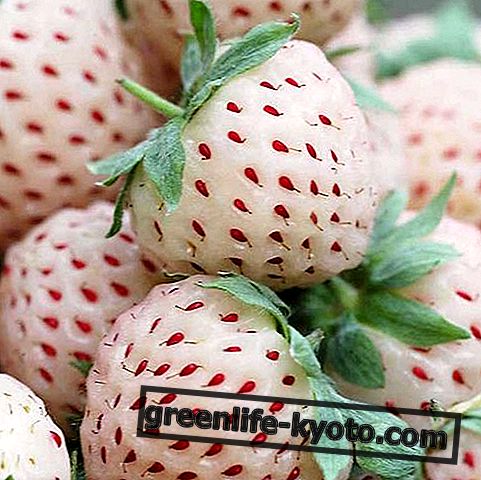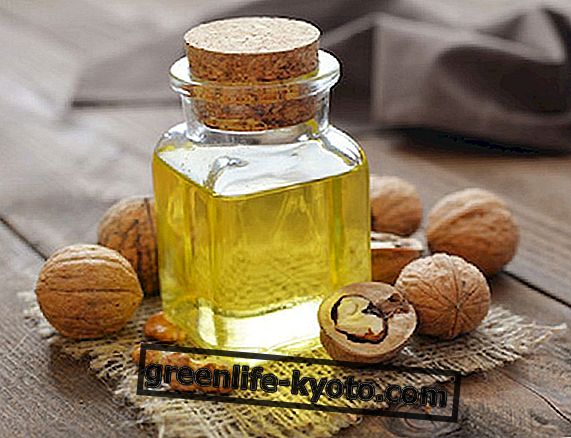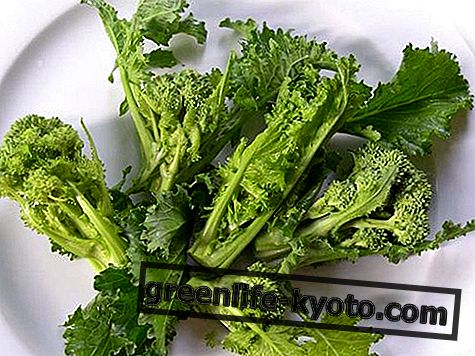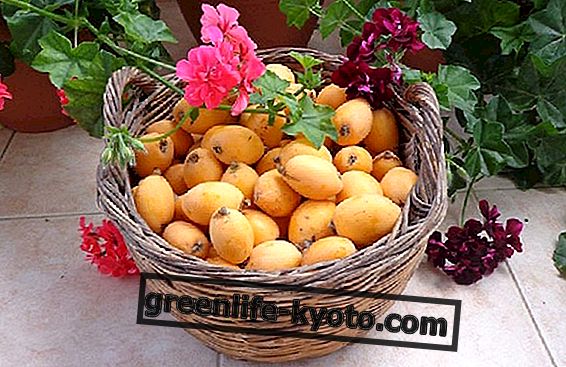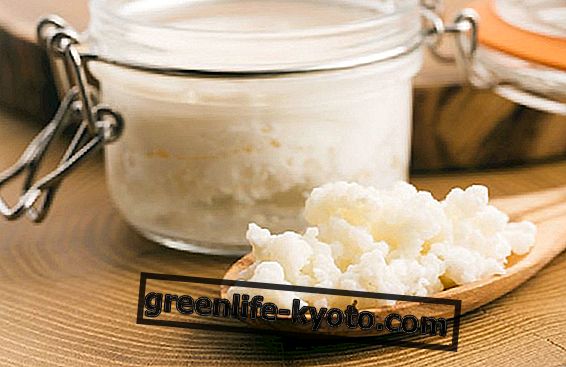The pharmacy of nature is rich in plants that have sedative and hypno-inducing properties . Their effects are often similar, they help each other, they become stronger. Let's find out better.

Which grass to sleep to choose?
The purpose of this special is to direct to the right choice, made on the basis of personal affinities with the herb that takes care of the cause, not only the symptom, with its energy, with its functional analogies. For this purpose every remedy should be observed in its physical description, in its components, in its interactions and indications. The invitation is also to look for images of herbs, to observe them in form, in color, because nature also speaks through its manifestations and brings them back to universal archetypes.
Asperula odorata, Galium odoratum
It is a perennial plant that reaches about 30 centimeters, with erect quadrangular stems characterized by dark green leaves that form a star from 6 to 8 points and white flowers in inflorescences.
It is native to Northern and Central Europe, it grows in the woods and develops more in the shady areas. Since ancient times it has been collected and used for cooking, but also for therapeutic purposes. It seems to owe its name to the feeling of roughness that is perceived by passing a hand over the leaves. In the past, dried flowers were used to perfume linen and to keep insects away.
The woodruff is an effective liver tonic as it promotes detoxification . It is used to fight depression, insomnia, hysteria and hypertension.
The asperula flower is considered by traditional medicine a tonic for the whole organism, thanks above all to its spasmodic effect against nocturnal cramps or joint pains and it is also particularly effective for fighting kidney stones and infections that affect the urinary tract. If consumed in excess the coumarin (active ingredient) can cause headaches and numbness.
Discover all the natural remedies for insomnia
Sweet orange: Citrus aurantium
Always green pyramid-shaped sapling, with oval and shiny leaves, with white and fragrant flowers, orange blossoms, and orange-colored fruits smaller than those of bitter orange.
It is native to the Far East, specifically in southern China and northern Burma, and was widespread in Europe by the Portuguese and the Arabs between the 7th and 12th centuries. The Chinese call the orange "chin-ch'in" - golden ball. In fact the sweet orange symbolizes the Sun, with a moderately Yang energy: the orange recalls the harshness of life with its bitter rind, but it promises very sweet slices and heady perfumes to those who have the perseverance to persevere without being discouraged!
It has antidepressant and calming properties, it is a cardiac and muscular tonic, it is antispasmodic, bactericidal detoxifier, febrifuge. It is indicated for forms of anxiety, insomnia, stress, digestive disorders, muscle spasms.
Hawthorn, Crataegus oxyacantha
Thorny shrub or small tree with white flowers and red ovoid berries surmounted at the apex by a small crown. In the past for this signature of a king it was considered to be a plant of the heart par excellence, intended as a balancing center of the whole being.
It is indicated for those who live as a dispossessed king, to those who let themselves be dominated by a brain that is too rational and no longer hears the voice of the heart. The Hawthorn shows how rationality and feeling can coexist: white flowers (brains) and red crowned berries (heart, king, centrality) coexist on the same plant.
It is widely used for the treatment of hypertension. It is native to Europe, northern Africa and western Asia. It grows spontaneously in hedges (in analogy to the need for order). Fresh, dried or extracted flowers are used. They are cardiotonic and promote a proper balance of blood pressure. They are antispasmodic and sedative of the central nervous system and the vegetative nervous system.
Camomile matricaria
It was part of the 12 sacred herbs of the Greeks, dedicated both to the Sun and to the Moon, due to its characteristic yellow radial center and white petals. Its botanical name "Matricaria" derives from the Latin Matrix, uterus or from Mater, mother and returns to the female genital apparatus and its beneficial influence on women's health . It has always been a remedy that helps mothers bring relief to their children to calm their irritability, pain, and teething neuralgia. His is a yin energy, very feminine and lunar, with a strong solar symbolic connotation.
The flower is smaller than that of the Roman Chamomile. The essential oil is blue, due to the azulene that is not present in the fresh flower, but is synthesized at the time of its distillation. The blue color of the chamomile matricaria is associated with the fifth chakra, that of the throat, linked to the word, to communication, to externalization!
Chamomile directly affects the central nervous system, including the vegetative components that govern visceral functioning. Untie knots, energy stagnations, rigidity of thought . Its dual nature is also reflected in its dual antagonistic effect: at low dosages it is an effective calming and antispasmodic, at higher dosages it can turn into a stimulant.
It has sedative, antispasmodic, digestive, febrifugal, diuretic, calming, diaphoretic properties, regulating periodic flows. It is indicated for inflammation (broad spectrum), muscle pain, colic, neuralgia, insomnia, nervous tension, dysmenorrhea.
Escolzia, Eschscholzia californica
This plant was introduced into Europe in the early 1800s but was already known and used by American Indians.
The Escolzia is a plant with orange-yellow flowers, rich in alkaloids: berberine, due to a sedative activity, protopine for an antispasmodic, relaxing (and even antibacterial) action, the heart calming criptopina, chelidonine as a painkiller and antispasmodic in the intestinal tract and in the gallbladder and is also known for its disinfectant, antibiotic and antifungal action; sanguinarine for the treatment and prophylaxis of oral hygiene. The plant's phytocomplex makes it effective for improving sleep quality and is indicated for delayed phase syndrome (delay in falling asleep). It is ideal for sleep disturbed by cramps.
The Escolzia can be used safely even for children and indeed it is an excellent adjuvant for problems related to that age group such as agitation, enuresis, and in case of pertussis as a sedative.
Given its high psychosomatic value, Escolzia is particularly recommended in all disorders of gastric symptomatology but of psychological cause, thanks to its analgesic properties. It is advised to use it during pregnancy or during lactation, and in those who show symptoms of hypotension.
Lettuce, Lactuca sativa
Annual herbaceous plant with a taproot-rich root, from which develops a rosette of broad, whole and hairless leaves. From the rosette of leaves also develops the floral stem that brings the yellow flowers collected in panicle.
Lettuce is rich in iron, potassium, calcium and magnesium. It is soothing, emollient, sedative, slightly anaphrodisiac. The consumption of the fresh plant helps in case of anemia, nervousness and constipation. It is also useful for lowering blood pressure.
Lavender, Lavandula spica
The name derives from the Latin lavandus = pulendo, for the Romans who used to put fresh flowers in infusion in the water in which they were washed. Its name evokes the smell of clean, little bags to perfume and disinfect cabinets and drawers, soaps, cologne.
Lavender was related to the virtues and purity of the soul and to Baptism. Its ear was used as an amulet to protect and propitiate fertility and prosperity. It is an herb of yin energy, under the control of the Moon, therefore of a feminine nature: its ears of small closed flowers recall the image of the young woman, whose whole personality must mature. In fact it accompanied the kits of the young brides with its strengthening and rebalancing scent.
It is born in sunny, arid, stony soils, in the Mediterranean area of Greece, Italy, France, Spain, Portugal. It flowers in June, the ears must be harvested still closed, before their essential oil spreads and disperses. It has anti-inflammatory, decongestant and analgesic properties. It is a nervous, relaxing, antidepressant, antiseptic, hypotensive rebalancing. It is indicated for treating sleep disorders, stress, headache, airway disorders. It is indicated for treating children.
Hops, Humulus lupulus
Herbaceous plant, dioica, tomentosa, especially climbing on willows and alders, which rise on soils rich in water (lunar characteristic). The drug is extracted from the female inflorescences called cones, collected at maturity.
These flowers are dried, the bracts are detached at the base of which are the glands that are put on the market. To clean them, they are beaten in a sieve together with sand, washing with water would cause the evaporation of the hormonal substances. They appear as an impalpable powder. Hops contain essential oil, lupulin, resins, a narcotic alkaloid, estrogens. The fluid extract is more used than dried flowers because palates do not always like the taste of hops.
Before meals as bitter, tonic, digestive, against stomach atony and weakness of the digestive system. Or in glandular and hepatic "traffic jams", due to its purifying properties. It is also indicated as a sedative and anaphrodisiac. Hop flowers with orange flowers infused after meals and at bedtime have a hypno-inducing effect . Even those suffering from insomnia are advised to fill the pillow with hop cones.
You can learn all the properties and the use of hops
Melissa officinalis
It is a perennial herbaceous plant that is somewhat reminiscent of nettle and is characterized by a pleasant lemon scent. The leaves are oval, serrated, the flowers are white or pink with a tubular calyx.
It grows wild in Europe and Asia, it must be harvested in May, before flowering. The name derives from the Greek and means bee. In North Africa bunches of Melissa leaves were used to attract and capture wandering swarms of bees. The essential oil of Melissa was part of the Royal Partial Ointment as a powerful medicine. For Pliny there was no medicine that cheered as much as Melissa. For the Arabs it served to ward off the anxieties of the spirit, drive away the melancholy thoughts and bad moods.
All the ancient herbalists used it to reinforce nerves and brains, Paracelsus considered it the elixir of long life. The Discalced Carmelites in the seventeenth century distilled the "anti-hysterical water" which as a basic principle contained a Melissa distillate and was used by women in cases of insomnia, hysteria, melancholy, fainting. It has a particular affinity with the female reproductive system: it facilitates ovulation, calms uterine spasms, against nausea during pregnancy, regulates the menstrual cycle and relieves pain.
Helps in various disorders of nervous origin: headaches, insomnia, exhaustion, spasms of the stomach, melancholy, hypochondria, palpitations, vertigo. It is used for the problems concerning the emotional sphere : hypersensitivity, anxiety, panic, agitation. It is febrifugal and sudoriferous. It is active on the heart: it lowers the pressure too high, but does not affect the low pressure. Calms the heart rate, calms breathing too fast. It is not recommended for those suffering from thyroid dysfunction.
You can find out all the tips and insights to sleep well
Poppy, Papaver rhoeas
Annual herbaceous with fusiform root and erect hairy, delicate, branched stem. The leaves are alternate, petiolate, mono or bipinnate. In June-July the flowers appear, solitary, large red with a black spot at the base of each petal. The fruit is an oboval capsule, with numerous black seeds. It is a typical weed of wheat and barley fields.
It is of saturnine symbolism, and represents laziness, misanthropy and softness of character. But it is also a symbol of power: it is said that Tarquinio the Superbus to teach his son's war strategies had had the tallest poppies in the garden cut down with a stick, meaning that in order for a kingdom to capitulate, the highest offices had to be suppressed first .
Presents morphine, meconic acid, resins, mucilage and coloring substances. The name poppy derives from the Celtic "papa" or jelly: it seems that its latex was mixed with children's jelly to favor a long and restorative sleep. It is indicated for insomnia, nervousness, excitement, anxiety, cough and bronchitis. Recommended for children and the elderly because there are no side effects, in controlled doses.
passionflower
The healing properties of the Passiflora incarnata were already known in antiquity by the Aztecs, who used it as a relaxing remedy. At the time of the First World War it was used for the treatment of "war anxieties".
These are plants originating from the tropical and subtropical areas of central and southern America; some from North America and other from Asia and are plants of incredible beauty and charm. It was brought to Europe by an Augustinian father in 1610 who associated the conformation of the flower to the passion and crucifixion of Jesus Christ: the crown of filaments of the ovary represents the crown of thorns, the 5 stamens the 5 wounds of Jesus, the 3 stigmas, the 3 nails, the 5 petals and the 5 sepals, the number of apostles remaining faithful.
Passion flowers appear in the summer and its fruits are edible. The aerial parts are used for the preparation of herbal and medicinal remedies. Passion flower is usually used for the treatment and prevention of anxiety, anxiety and insomnia due to agitation. It has a relaxing and sedative effect on the central nervous system.
Its calming action guarantees a peaceful night sleep without waking up. Its antispasmodic action allows its use in case of problems due to muscular contractions, such as menstrual cramps. It is a female plant and by analogy it may be indicated to alleviate any disorders present during menopause.
For herbal purposes the younger leaves and branches are collected, but the properties of its fruits should not be underestimated. The fruits of the passion flower are in fact rich in vitamin C and have a high refreshing power (maracuja). Its use can also be useful in case of asthma, palpitations, attention deficit and high blood pressure.
It can also be taken in the form of Passiflora mother tincture.
Willow, Salix alba
Dioic tree with greyish bark and broad foliage. The pendulous and thin branches, flexible, have elongated and thin yellow-green or pale green leaves. It blooms around mid-April with pendulous catkins, the fruits have no capsules. In nature it is present along watercourses, in moors, in wet areas.
The Willow is considered the tree of feminine energy, protects gently, and its weeping branches are associated with tears and melancholy. " In adversity, be like the willow that favors the fury of the hurricane by bending here and there, according to the blowing of the wind; then after the storm recomposes its branches ". (Thought of Zen wisdom).
Contains glycoside, salicylic acid, rubber, tannins; it is febrifuge, analgesic, calming, astringent. It is used to facilitate sleep, in case of dyspepsia, rheumatic pains, fever. It is contraindicated in interaction with other analgesic remedies because it enhances their effects. It is not recommended for use by those suffering from ulcers or gastric disorders because it increases acidity.
Tiglio, Tilia tomentosa
Large tree with erect stem and initially smooth bark, then cracked in old age, gray with numerous veins. The leaves are dark green, shiny and ample and heart-shaped, with a serrated edge. In June-July it bears white-yellowish, fragrant flowers. The fruits are the size of a pea with a hard pericarp.
The Tiglio according to Greek mythology is a plant dear to Aphrodite and for this symbol of femininity. It is considered the tree of conjugal love: it is said that Baucis and Philemon were two old spouses who lovingly welcomed Zeus and Hermes in human form in their home. To reward them, the gods fulfilled their desire to be able to die together in old age.
One day the two very old spouses began to transform: Bauci in an oak and Philemon in a linden, they were so united forever and close. It has essential oil, mucilage, tannins and sugars; it is soothing, antispasmodic, sedative, antirheumatic, diaphoretic.The Linden is indicated for insomnia, nervousness, headache, influences, cough, lowers pressure
Valeriana officinalis
Perennial herbaceous with short fibrous rhizome and erect and majestic stem, hollow, grooved. In spring-summer it presents small white or pink flowers collected in umbrellas and perfumed. It grows in damp woods, along streams.
Valerian can be defined as polymorphic, as it changes shape depending on the different climatic conditions. The term valerian derives from the Latin valere = to have strength, because it was known to benefit health.
It has sedative, antispasmodic, antineuralgic properties. Indicated against all anxiety manifestations, depression, migraine, neurasthenia. It facilitates sleep. Excessive use of the substance can be addictive and is contraindicated for those suffering from low blood pressure.
Verbena odorosa, Lippia citriodora
It is a plant with a woody stem that can reach up to 2 meters in height, has lance-shaped leaves and small white flowers arranged in spikes. It was one of the most precious magic herbs of antiquity, the Romans attributed it propitiatory properties and used it in rites of purification of the altars.
The Celts and the Germans used it in their religious and magical rites, to foster concentration and mental lucidity; in fact it responds to a mercurial symbolism, where intelligence and communication are the basic characteristics.
It has a moderately Yang energy. The verbena exercises its functions on the nervous system, with a tonic or calming effect, of balancing the mood. It is useful for stressed and hyperactive people, to ease psychosomatic tensions in the neck and shoulders with headaches or digestive disorders.
Leaves of the verbena odora are used, which have aromatic properties. It has antispasmodic, anti-inflammatory, antiseptic properties, it is a calming and rebalancing nervous, a digestive. It is indicated for treating stress, insomnia, anxiety, depression, tachycardia, neuralgia. Use during pregnancy is not recommended.
Find out when the World Day of Sleep is
More articles on sleeping herbs:
> Herbal teas for better sleep
> 10 herbs to sleep well
